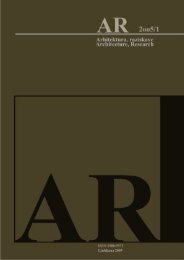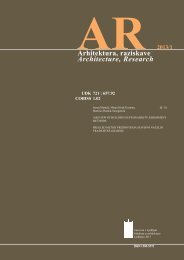2o12/1 - Fakulteta za arhitekturo - Univerza v Ljubljani
2o12/1 - Fakulteta za arhitekturo - Univerza v Ljubljani
2o12/1 - Fakulteta za arhitekturo - Univerza v Ljubljani
Create successful ePaper yourself
Turn your PDF publications into a flip-book with our unique Google optimized e-Paper software.
AR 2012/1Amir Čaušević, Nerman RustempašićEvaluation of stability of masonry minaret in high seismicity regiondisplacements, nor in the obtained extreme strain values, exceptin the case of the minaret variant in zone VII.The slenderness parameter of the minaret, which represents therelation between the minaret height and the cross section diameter,was considered = H/d. Taking into account the calculatedstresses and horizontal displacements, the approximate value ofH/d =10.0 (the real value is H/d = 12.91) is the recommendedminaret slenderness (H/d), determined by the investigationsconducted on models of the Ferhad-Pasha’s Mosque minaret.Slika 3: Vertikalne in horizontalne plošče iz plastike ojačane s steklenimi vlakni(FRP).Figure 3: FRP system - vertical and horizontal FRP sheets.Tabela 2: Določanje optimalne vitkosti minareta Ferhad-pašine mošeje.Table 2: Determining the optimum slenderness of the Ferhad-Pasha’s Mosqueminaret.Strengthening proposalsTo reuduce the tensile stress, large due to seismic movements,it is recommended to install vertical carbon, reinforced fibrecomposite NSM CFRP sheets, sealed with appropriate plaster.It is necessary to perform this intervention over a major partof the minaret from the base, and to pay special attention tosections with high decreases of cross-sections at the place ofthe šerefet and immediately after it. For vertical individualconstructions, such as clock towers, towers and minarets, thestiffening capacity is increased via installation of vertical ironelements or some synthetic fibres. It is proposed here to achievesufficient tensioning capacity using the carbon composite.Analysis indicated this prevents further damaging of thebuilding, and provides a satisfactory capacity level.The fibre model assumes that the structure has a certain numberof axial fibre sheets to reduce tension stresses. The use of testedmaterials of good quality and high tensile strength, which ensurefast, cost-effective and efficient installation, is desirable.Using modern structural conservation techniques allows usto intervene respecting the original concept and achieving askilled balance between safety and the necessary permanence,in line with the philosophy of minimum intervention and acareful assessment of the possibilities offered by old and newtechnologies. The proposed intervention aims to apply, byappropriate techniques, a reticular system made of vertical andhorizontal FRP sheets glued to the masonry. Figure 3. shows theFRP system as it appears on the inner walls of the structures.Carbon fibres with a specific weight of γ = 6•10-5 MN/m 2 ,t =0.000335 m in thickness and w = 0.20 m in width, are tobe employed. With a view to preventing possible cracks onthe outer side of the minaret, extra reinforcement in form ofadditional CFRP rods installed into stone block joints at everyfour meters of the minaret height. The rods are to be bondedusing appropriate plaster.The ultimate tensile strength of the fibres is 4.800 MN/m 2 . TheFRP system ensures a monolithic behaviour of the masonry inthe case of high-intensity earthquakes.An FRP tie system is to be applied to the inner walls andanchored at the base by a reinforced concrete slab, independentof the tower’s foundation. The intervention enhances the seismiccapacity of the structure and is fully provisional as it may beremoved by heating the FRP with a hot air jet.This would not constitute a permanent intervention to theminaret, as replacing the concept would not be hard if a moreelegant solution to the stability of the minaret was to be found atsome future date.Advantages of this type of interventions are: Easy to handle andtransport; ability of real-time monitoring; excellent fatigue andfracture resistance; high specific strength properties (20-40%weight savings); lower thermal expansion properties; resistanceto chemical agents and impermeability to water; tailor madesolution; outstanding corrosion resistance; lower tooling costalternatives; in comparison with conventional material verygood ratio rigidity / self weight.The Venice Charter (and the Charter of Krakow in addition)regards historic monuments as architectural works that attestto the culture and tradition of peoples over the centuries. Itis incumbent upon us to preserve and safeguard them intactfor future generations. Interventions should have respectfor the original materials; required replacements need to beharmoniously integrated with the whole, but easily identified;and additions are acceptable only if their influences on the otherparts of the monument and/or its surroundings are negligible.A special problem is the implementation of effective lawsand recommendations, very often leading to complex andunwarrantable solutions.The truth is that they were not designed to be implemented incultural heritage. When traditional techniques are shown tobe inadequate, historic properties may be consolidated usingmodern structural conservation techniques that have beenproven by scientific research and are already empirically triedand tested. Structural codes for new buildings, much less olderones, are not written to ensure that buildings are strong enoughto survive a large earthquake without major damage. We shouldnot forget that the objective of the code requirements is toavoid collapse. This is a technique extensively used for westernEuropean historic structures and seems very appropriate forreversible interventions.The second proposal includes traditional retrofit strategies basedon steel.The structure of the Ferhad-Pasha's Mosque minaret was alreadystrengthened in 1986. After the earthquake (magnitude was 6.0)the minaret was affected by decay and cracks that were visible.At that time the Banja Luka area was a part of the seismic zoneVIII. To take off the tensile stress, which appears due to seismic29

















